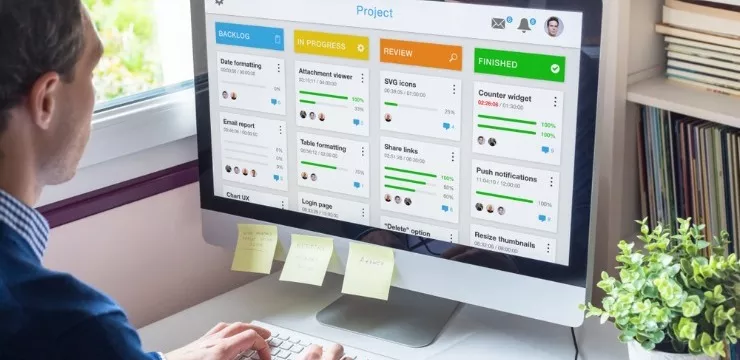
Applied to employee-centered disciplines such as HR and employee experience management, agile methods can generate significant benefits for both employees and employers.
At first glance, agile methods may not to seem very applicable to such business disciplines. After all, many employees will stay with a company for years, if not decades, so why implement business practices aimed at speed and flexibility?
The answer is that the workforce and the workplace are undergoing major changes, and employee management practices that remain static won’t be able to adjust to those changes. As a result, employers won’t be able to maintain a strong employer brand, maintain an agile workforce, or attract top talent, among other things.
5 Reasons to Use Agile Methods in HR
Here are five concrete benefits to applying agile methods in HR, employee experience management, and other employee-focused disciplines:
1. Maintain employee engagement
The employee experience can and does dramatically impact important employee metrics such as engagement, performance, and productivity.
Yet when employee needs change, employee engagement strategies should also change.
For instance:
- When working from home becomes the norm, HR should adopt digital-first workflows and employee engagement plans
- When the organization’s digital ecosystem evolves, HR should implement training plans that keep employees skilled and engaged
- When rapid organizational changes are needed, HR should be prepared to implement agile change management methods
In short, when business needs change, agile methods can help HR make the needed changes to the workplace and the workforce.
2. Attract and retain a pool of top talent
At first glance, agile may seem to be irrelevant to talent management.
Yet there are several types of change that are continually affecting the workplace, the workforce, and, as a result, talent management.
For instance:
- Digital innovation drives continuous organizational change, which requires an up-to-date talent pool
- Talent shortages are quickly becoming common in certain business functions, such as programming, and companies need to change talent management strategies to keep up with those changes
- Changes to talent needs require new talent management strategies, such as the use of gig workers, contract workers, flex time, and hybrid offices
In short, since talent needs are constantly evolving, so too should talent management strategies.
3. Keep up with the dynamic needs of the marketplace
Customer needs, the global economy, and global business functions are also changing quickly – and as they evolve, so too should HR strategies.
If the workplace and the workforce fall behind the times, after all, the business will also get left behind.
An agile workforce can help a business keep up with:
- Customers’ changing expectations
- Competitors and the changing dynamics of the market
- Employees’ changing expectations of their employers
- New norms in business practices, workplace practices, and hiring practices
- Changing cultural and social norms
As most of us are aware, today’s marketplace is changing rapidly and it will continue to change for years to come – and as it does, HR professionals should be prepared to adapt their business practices to keep up.
4. Stay up-to-date with changing workforce expectations
Employees’ needs are also changing, as mentioned. If those needs aren’t met, then turnover can increase, while engagement and performance can drop.
Naturally, not all employees want the same thing.
However, there are trends that HR professionals should pay attention to.
For instance, many employees prefer:
- Employers who provide training and career development options
- Flexible work options, such as flex-time and remote work opportunities
- Promotional opportunities
Every employee wants a pleasant workplace, team, and employer, so it is important to deliver that as much as possible. Yet also recognize that what employees consider valuable is continually changing.
5. Improve organizational resilience
Organizational resilience during radical change depends on many factors, one of which is employee agility.
When HR and the workforce can adapt quickly, the organization can also adapt quickly. When they cannot, however, the organization also falls behind.
An agile workforce:
- Adopts new technology quickly and efficiently
- Is open to learning and change
- Doesn’t resist organizational change
Because employees are ready and willing to change, they are also capable of supporting rapid business changes. This can certainly be helpful during disruptive crises such as the COVID-19 pandemic, but also during natural changes in the market.
How to Apply Agile Methods in HR
Every business is different and there is no one-size-fits-all approach to applying agile in HR.
Instead, it is best to adopt practices bit by bit, implementing incremental changes and improvements, testing and learning, then moving forward based on those outcomes.
Here are a few steps to consider taking when deploying agile methods in your HR department:
- Redefine agile principles and them to HR practices, employee experience management, and other employee-centered disciplines
- Invest in a hybrid office model that makes the best of both remote and onsite work models
- Maintain a workforce composition that is more fluid and exploits both contractors and full-time employees
- Use data-driven methods to monitor and adjust HR practices
- Cross-train employees to improve workforce agility
To make the most of agile in HR, in short, managers should fully integrate agile principles into their own practices and mindsets. That is, agile itself is about staying responsive, so the methods used should be data-driven, fully responsive, and ready to change as needed.
WalkMe Team
WalkMe spearheaded the Digital Adoption Platform (DAP) for associations to use the maximum capacity of their advanced resources. Utilizing man-made consciousness, AI, and context-oriented direction, WalkMe adds a powerful UI layer to raise the computerized proficiency, everything being equal.



